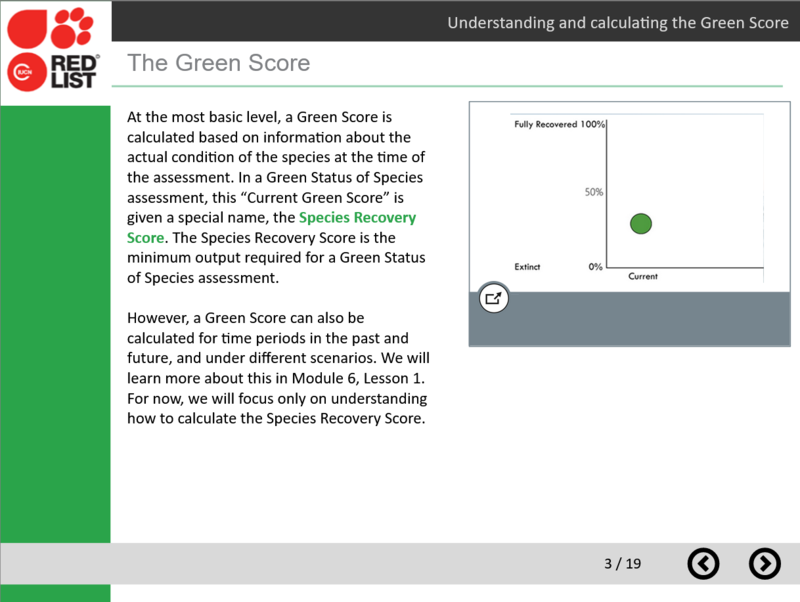Online Red List and Green Status Training
IUCN, in collaboration with The Nature Conservancy (TNC), has developed online training courses for people to learn how to prepare assessments for publication on The IUCN Red List of Threatened Species™. Two courses are available:
Both courses are hosted by TNC on their ConservationTraining website, and are free. The Red List Training course is available in English, French and Spanish; currently the Green Status course is only available in English, but French and Spanish versions will be available soon.

IUCN Red List Assessor training course
The full Red List Assessor training course is here, and covers the following topics:
-
What is the IUCN Red List, and how is it used? (Module 1: Introduction to the IUCN Red List)
-
The Red List assessment process (Module 2: IUCN Red List assessments)
-
How to apply the IUCN Red List Categories and Criteria (Module 3: IUCN Red List Categories and Criteria)
-
What supporting information is required for Red List assessments? (Module 4: Supporting information for IUCN Red List assessments)
-
Preparing distribution maps (Module 5: IUCN Red List mapping standards)
-
Storing and managing IUCN Red List data (Module 6: IUCN Species Information Service)
-
Regional and national Red List assessments (Module 7: Regional IUCN Red List assessments)
The course also includes a final course exam (Module 8), which is designed to test your knowledge of the IUCN Red List and your skills in calculating the various parameters used in the assessment process. Passing the exam will entitle you to a certificate to prove that you have successfully completed the course. An Advanced level exam is also available (Module 9) for Red List Trainers and people involved in managing assessment projects.
Preparing IUCN Red List assessments requires comprehensive knowledge on the application of the IUCN Red List Categories and Criteria, to ensure that assessments are conducted according to scientifically underpinned and exacting standards.
This process differs slightly depending on whether you are a Global Assessor assessing the global extinction risk of species for publication on the IUCN Red List, or a Regional Assessor assessing species’ subglobal extinction risk for a regional or national Red List.
|
Global Assessors: Please complete modules 1 to 6. Module 7 (regional assessments) is optional, but is important for assessing subpopulations within a species. |
|
Regional Assessors: Please complete modules 1, 2, 3 and 7. Modules 4 (supporting information), 5 (mapping standards) and 6 (SIS) are optional, but are important if you intend to submit endemic species assessments for publication on the IUCN Red List. Modules 4-6 are also required if you are working on an IUCN-led regional assessment project. |
We advise you to take modules 1-3 in order. Once you have completed modules 1-3, the other modules can be taken in any order.


The Green Status of Species training course
The Green Status of Species (GSS) course is available here, and covers the following topics:
-
What is the purpose of the GSS, and what is its relationship to the Red List and conservation planning?
-
The key terms used in GSS assessments.
-
The criteria used for GSS assessments and how to assign species recovery categories.
-
How to account for historic, current and future ranges in a GSS assessment.
-
How to assess the current state of a species.
-
Measuring the impact of conservation actions on species.


Getting Started
The courses hosted on ConservationTraining.org are available free of charge, but you do need to create a user account to take the courses (this is also free). If you do not already have a user account for the ConservationTraining website, go to the website home page (https://www.conservationtraining.org), open the Sign Up page and click on "Create a new account".
Please note that the final course certificates for these courses are not professional qualifications. To become a successful IUCN Red List or Green Status of Species assessor, you will need to use the knowledge gained from the course to complete and submit assessments and have these accepted for publication.
External Link

